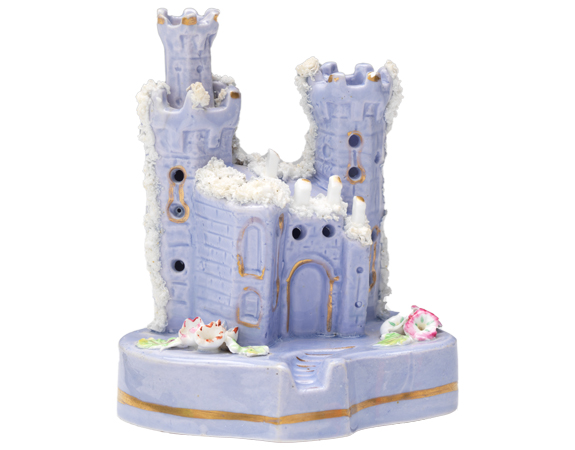Castles, Cottages, and Crime Opens July 10 at Nelson-Atkins
Exhibition Elevates Victorian Ceramics
Kansas City, MO, June, 15 2021 – A whimsical exhibition celebrating a unique period in the British Victorian decorative arts will be on view at The Nelson-Atkins Museum of Art in Kansas City from July 10 to March 6, 2022. Castles, Cottages and Crime features more than two dozen small ceramic structures from the museum’s permanent collection, along with several local loans and a new gift. Most were made by Staffordshire potteries in England’s West Midlands in the mid-1800s and served to decorate British middle- and working-class homes.
William Keyse Rudolph, the Nelson-Atkins Deputy Director, Curatorial Affairs, arrived at the museum in Spring 2020 just as it was closing due to the pandemic. He spent his time familiarizing himself with the collection and was delighted to discover a cache of unique ceramics.

“These quirky ceramics recall a specific period in British history, one that might have been overlooked if not for William casting a fresh eye on the museum’s permanent collection,” said Julián Zugazagoitia, Menefee D. and Mary Louise Blackwell CEO & Director of the Nelson-Atkins.
“This exhibition is what happens when a new curator goes digging in storage,” said Rudolph. “I love these little structures. They each have a fascinating story that I’m looking forward to sharing with our visitors.”
The ceramics fulfilled both ornamental and useful functions. Before the advent of improved ventilation, houses were arenas of unpleasant odors from kitchens and chamber pots. Pastilles, similar to insence cones, were dipped into essential oils and placed in the openings in the back of these ceramics. When lit, the smoke curled through the cottage’s or castle’s chimneys, acting as an air freshener.

The ceramics are grouped in three categories. Some are imagined rural cottages embellished with graceful florals; some are based on actual castles dotting the English countryside; and several depict places where gruesome crimes occurred. These ceramics commemorate “murder houses,” where actual crimes were committed. Sensational stories of true crime fascinated audiences then, much like today. The museum’s “murder houses” commemorate the Stanfield Hall Murders of 1848, arising out of a property dispute; as well as the so-called Rugeley Poisoner.
The collection of buildings was the gift of Richard A. Wood in memory of Virginia Conklin Wood.
Image captions: English, Staffordshire. Pastille Burner in the form of a Castle, about 1840–1860. Glazed earthenware with polychrome enamel decorations and gilding; 4-1/8 x 3-1/2 in. (10.4775 x 8.89 cm.) Nelson-Atkins Museum of Art, gift of Richard A. Wood in memory of Virginia Conklin Wood, 2021.5.23
English, Staffordshire. Pastille Burner in the form of a Cottage, about 1840–1860. Glazed earthenware with polychrome enamel decorations and gilding; 4-3/4 x 4 in. (12.065 x 10.16 cm.) Nelson-Atkins Museum of Art, gift of Richard A. Wood in memory of Virginia Conklin Wood, 2021.5.11
Organized by The Nelson-Atkins Museum of Art.
Media Partner: The Independent
About The Nelson-Atkins Museum of Art
The Nelson-Atkins in Kansas City is recognized nationally and internationally as one of America’s finest art museums. The museum, which strives to be the place where the power of art engages the spirit of community, opens its doors free of charge to people of all backgrounds. The museum is an institution that both challenges and comforts, that both inspires and soothes, and it is a destination for inspiration, reflection and connecting with others.
The Nelson-Atkins serves the community by providing access to its renowned collection of more than 42,000 art objects and is best known for its Asian art, European and American paintings, photography, modern sculpture, and Native American and Egyptian galleries. Housing a major art research library and the Ford Learning Center, the Museum is a key educational resource for the region. In 2017, the Nelson-Atkins celebrated the 10-year anniversary of the Bloch Building, a critically acclaimed addition to the original 1933 Nelson-Atkins Building.
The Nelson-Atkins is located at 45th and Oak Streets, Kansas City, MO. Hours are 10 a.m.–5 p.m. Friday through Monday; 10 a.m.–9 p.m. Thursday; closed Tuesday and Wednesday. Admission to the museum is free to everyone. For museum information, phone 816.751.1ART (1278) or visit nelson-atkins.org.
For media interested in receiving further information, please contact:
Kathleen Leighton, Manager, Media Relations and Video Production
The Nelson-Atkins Museum of Art
816.751.1321
kleighton@nelson-atkins.org